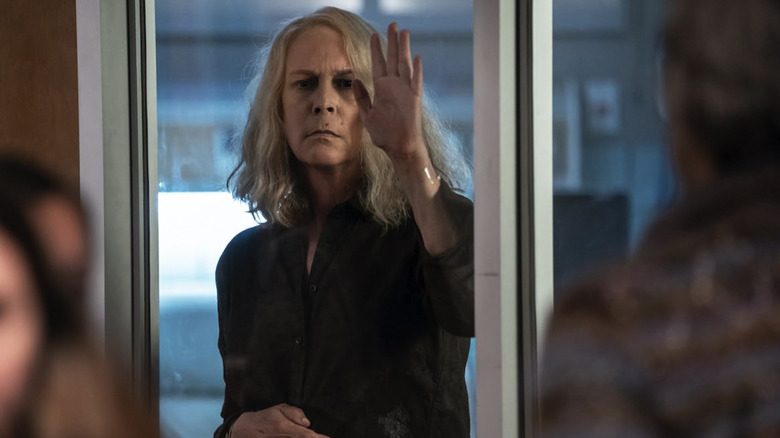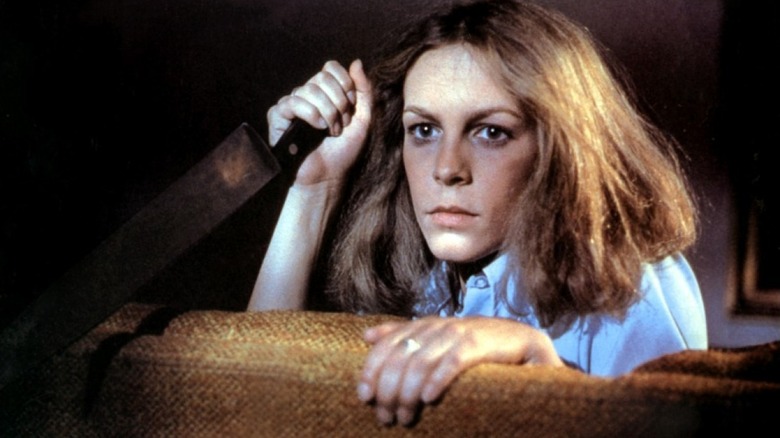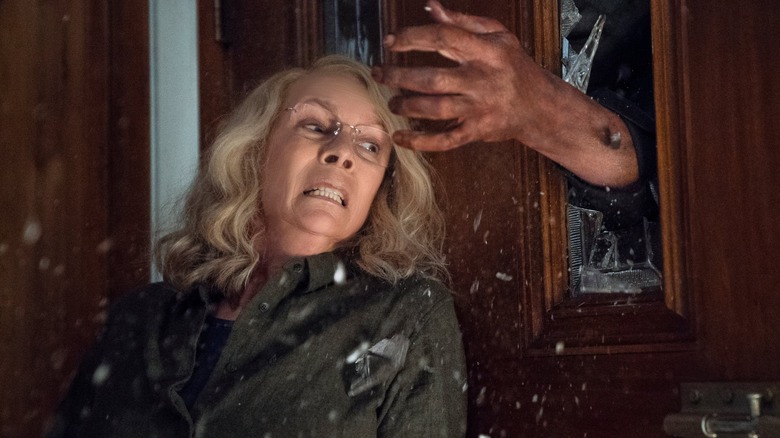Halloween Kills Originally Featured A Young Laurie Strode As A Main Character
David Gordon Green's 2018 slasher film "Halloween," a direct sequel to John Carpenter's 1978 slasher film also called "Halloween," famously ignored the nine "Halloween" sequels and remakes made from 1981 to 2009. The original film starred Jamie Lee Curtis as a teenage babysitter named Laurie Strode who ran afoul of a mysterious, silent masked killer named Michael Myers. In the original "Halloween II," it was revealed that Laurie was Michael's long-lost sister, a conceit Green would handily abandon for his 2018 update. Instead, Laurie was, 40 years later, still wounded by the events of the 1978 film, and had become a ragged survivalist, outfitting her home with booby traps and training herself how to use weapons in the off chance that Michael should ever escape the local mental institution and begin his killing spree again. Perhaps predictably, that very thing happens.
Green's "Halloween" ends with Laurie trapping Michael in a burning building, seemingly to die forever. Sadly, at the beginning of the follow-up film, Green's "Halloween Kills" from 2021, Laurie seems to have forgotten that firefighters exist in her hometown, and Michael flees the fire to continue his murders on the very same night. Much of "Halloween" and "Halloween Kills" take place over the same 24-hour period.
It seems that, in the original draft of "Halloween Kills," however — written by Green, Danny McBride, and Scott Teems — audiences were going to see multiple flashbacks to 1978, including sequences with a young Laurie Strode, likely re-enacting the events of Carpenter's film. The details of these scenes were explained in Abbie Bernstein's new book "Halloween: The Official Making of Halloween, Halloween Kills and Halloween Ends."
The young Laurie Strode chronicles
It should be noted that the 1978 "Halloween" was Curtis' first major acting role. For the first part of her career, Curtis worked largely in horror, making "The Fog," "Prom Night," "Terror Train," and "Halloween II" over the course of the next few years. Curtis has also remained incredibly loyal to the "Halloween" series, having appeared in eight of the 13 movies to date (if one counts a voice cameo in "Halloween III: Season of the Witch"). Indeed, it was Curtis' status as a horror icon that ultimately put the kibosh on screenwriter Teems' idea to set extended portions of "Halloween Kills" in 1978. To do so would have meant casting a younger actress as the young Laurie, and ultimately Teems' co-screenwriters, Green and McBride, decided that wasn't entirely wise.
There was also brief talk of casting a younger actress, but then using special effects to superimpose a young Curtis' face over the new actress's face, a practice that would have taken far too much time and money to achieve. Incidentally, there are multiple scenes in "Halloween Kills" set in 1978, and there are a few brief shots of Dr. Loomis, the character played by Donald Pleasance in the original. An actor named Tom Jones, Jr. played Loomis, as he and Pleasance, with the right makeup, look uncannily alike. Dr. Loomis was voiced by Colin Mahan, who also provided a voice recording for the character in the 2018 "Halloween."
Loomis, however, was used sparingly in the "Kills" flashbacks, and his scenes were shot at night, allowing the filmmakers to obscure his face and kind of "cheat" his presence. The first draft of "Kills" might have included more of Laurie than it did of Dr. Loomis, so a lookalike was out of the question.
'I love a lot of this, but...'
Teems recalled Green's reaction to his ideas, and quoted him saying: "I love a lot of this, but I'm realizing that there is unresolved stuff from the first movie, and the second movie needs to be a continuation of the night." Teems also admitted that he might have been a little too jocular when writing a slasher sequel, saying "Also, I think my script was too funny — it got gnarly, but it wasn't quite tonally right."
There are plenty of playful slasher movies in the world, but the "Halloween" movies have always been comparatively somber films when compared to the wild imagination of "A Nightmare on Elm Street" or the forthright trashiness of the many "Friday the 13th" sequels. Despite the fact that Green and McBride had previously worked on multiple comedy films together, including "Pineapple Express," and "Your Highness," having a jokey tone in their "Halloween" films would indeed have been mildly inappropriate.
McBride himself was quoted as more or less agreeing with Green, saying that he "liked [the extended flashbacks], but people should be more concerned with what's happening in the storyline we set up." It was important that "Halloween Kills" answer the question of what Laurie and Michael Myers were doing in the present, and not spend a lot of time mucking about in the past. "Halloween Kills" is largely about the trauma that Michael did to the local community of Haddonfield, Illinois, and it ends with the locals ganging up on him to beat him up with hockey sticks and baseball bats.
The existence of the 2022 film "Halloween Ends" implies that they were not successful in stopping the mad killer.


